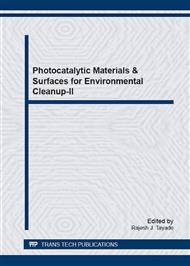[1]
M.N. Rashed, A.A. El-Amin, Photocatalytic degradation of methyl orange in aqueous TiO2 under different solar irradiation sources, Int. J. Phys. Sci. 2 (2007) 73-81.
Google Scholar
[2]
J.T. Li, B. Bai, Y.L. Song, Degradation of Acid Orange 3 in aqueous solution by combination of fly ash/H2O2 and ultrasound irradiation, Indian J. Chem. Technol. 17 (2010) 198-203.
Google Scholar
[3]
M.S. Khehra, H.S. Saini, D.K. Sharma, B.S. Chadha, S.S. Chimni, Comparative studies on potential of consortium and constituent pure bacterial isolates to decolorize azo dyes, Water Res. 39 (2005) 5135-5141.
DOI: 10.1016/j.watres.2005.09.033
Google Scholar
[4]
S. Netpradit, P. Thiravetyan, S. Towprayoon, Application of waste, metal hydroxide sludge for adsorption of azo reactive dyes, Water Res. 37 (2003) 763-772.
DOI: 10.1016/s0043-1354(02)00375-5
Google Scholar
[5]
S. Meric, H. Selcuk, V. Belgiorno, Acute Toxicity Removal in Textile Finishing Waste Water byFenton's Oxidation, Ozone and Coagulation-Flocculation Processes, Water Res. 39 (2005) 1147-1153.
DOI: 10.1016/j.watres.2004.12.021
Google Scholar
[6]
J.S. Ledakowicz, T. Koprowski, W. Machnowski, H.H. Knudsen, Membrane filtration of textile dyehouse wastewater for technological water reuse, Desalination. 119 (1998) 1-9.
DOI: 10.1016/s0011-9164(98)00078-2
Google Scholar
[7]
J.A. Laslo, Regeneration of Azo Dye-Saturated Cellulosic Anion Exchange Resin by Burkholderiacepacia Anaerobic Dye Reduction, Environ. Sci. Technol. 34 (2000) 167-172.
DOI: 10.1021/es990918u
Google Scholar
[8]
I. Bridgeman, A.T. Peters, Photochemical Degradation of Aminoazobenzene Disperse Dyes in Ethanolic solution: Part I: Effect of Concentration, Water, and Temperature, Text. Res.J. 44 (1974) 639-645.
DOI: 10.1177/004051757404400901
Google Scholar
[9]
X. Wang, J. Jia, Y. Wang, Electrochemical degradation of reactive dye in the presence of water jet cavitation, Ultrason. Sonochem. 17 (2010) 515-520.
DOI: 10.1016/j.ultsonch.2009.10.023
Google Scholar
[10]
W.S. Kuo, P.H. Ho, Solar photocatalytic decolorization of methylene blue in water, Chemosphere. 45 (2001) 77-83.
DOI: 10.1016/s0045-6535(01)00008-x
Google Scholar
[11]
N. Capalash, P. Sharma, Biodegradation of Textile Azo Dyes by Phanerochaete chrysoporium, World J. Microbiol. Biotechnol. 8 (1992) 309-312.
DOI: 10.1007/bf01201886
Google Scholar
[12]
D.K. Sharma, H.S. Saini, M. Singh, S.S. Chimni, B.S. Chadha, Biological treatment of textile dyeacid violet-17 by bacterial consortium in an up-flow immobilized cell bioreactor, Lett. Appl. Microbiol. 38 (2004) 345-350.
DOI: 10.1111/j.1472-765x.2004.01500.x
Google Scholar
[13]
S. Palamthodi, D. Patil, Y. Patil, Microbial degradation of textile industrial effluents, Afr. J. Biotechnol. 10 (2011) 12657-12661.
DOI: 10.5897/ajb11.1618
Google Scholar
[14]
T.J. Mason, Ultrasound in synthetic organic chemistry, Chem. Soc. Rev. 26 (1997) 443-451.
Google Scholar
[15]
P.R. Goate, A.B. Pandit, A review of imperative technologies for wastewater treatment II: hybridmethods, Adv. Environ. Res. 8 (2004) 553-597.
Google Scholar
[16]
F. Chen, J. Zhao, H. Hidaka, Adsorption factor and photocatalytic degradation of dye constituent aromatics on the surface of TiO2 in the presence of phosphate anions, Res. Chem. Intermed. 29 (2003) 733-748.
DOI: 10.1163/156856703322601744
Google Scholar
[17]
M. Smelcerovic, D. Dordevic, M. Novakovic, M. Mizdrakovic, Decolorization of a textile vat dye by adsorption on waste ash, J. Serb. Chem. Soc. 75(2010) 855-872.
DOI: 10.2298/jsc090724057s
Google Scholar
[18]
S. Dai, Y. Wu, T. Sakai, Z. Du, H. Sakai, M. Abe, Preparation of Highly Crystalline TiO2 Nanostructures by Acid-assisted Hydrothermal Treatment of Hexagonal-structured Nanocrystalline Titania/ Cetyltrimethyammonium Bromide Nanoskeleton, Nanoscale Res. Lett. 5(2010).
DOI: 10.1007/s11671-010-9720-0
Google Scholar
[19]
G. Bertoni, E. Beyers, J. Verbeeck, M. Mertens, P. Cool, E.F. Vansant, G.V. Tendeloo, Quantification of crystalline and amorphous content in porous TiO2 samples from electron energy loss spectroscopy, Ultramicroscopy. 106 (2006) 630-635.
DOI: 10.1016/j.ultramic.2006.03.006
Google Scholar
[20]
E.J. Fontenot, Y.H. Lee, R.D. Matthews, G. Zhu, S.C. Pavlostathis, Reductive decolorization of a textile reactive dye bath under methanogenic conditions, Appl. Biochem. Biotechnol. 109 (2003) 207-225.
DOI: 10.1385/abab:109:1-3:207
Google Scholar
[21]
W. Bahnemann, M. Muneer, M.M. Haque, Titanium dioxide-mediated photocatalysed degradation of few selected organic pollutants in aqueous suspensions, Catal. Today. 124 (2007) 133-148.
DOI: 10.1016/j.cattod.2007.03.031
Google Scholar
[22]
X.K. Wang, G.H. Chen, W.L. Guo, Sonochemical degradation kinetics of Methyl Violet in aqueous solutions, Molecules, 8 (2003) 40-44.
DOI: 10.3390/80100040
Google Scholar
[23]
J.B. Ji, X.H. Lu, Z.C. Xu, Effect of ultrasound on adsorption of Geniposide on polymeric resin, Ultrason. Sonochem. 13 (2006) 463-470.
DOI: 10.1016/j.ultsonch.2005.08.004
Google Scholar
[24]
S. Anandan, P.S. Kumar, N. Pugazhenthiran, J. Madhavan, P. Maruthamuthu, Effect of loaded silver nanoparticles on TiO2 for photocatalytic degradation of Acid Red 88, Sol. Energy Mater. Sol. Cells. 92 (2008) 929-937.
DOI: 10.1016/j.solmat.2008.02.020
Google Scholar
[25]
C.H. Liang, F.B. Li, C.S. Liu, J.L. Lu, X.G. Wang, The enhancement of adsorption and photocatalytic activity of rare earth ions doped TiO2 for the degradation of orange I, Dyes Pigm. 76 (2008) 477-484.
DOI: 10.1016/j.dyepig.2006.10.006
Google Scholar
[26]
J.W. Shi, J.T. Zheng, P. Wu, Preparation, characterization and photocatalytic activities of holium-doped titanium dioxide nanoparticles, J. Hazard. Mater. 161 (2009) 416-422.
DOI: 10.1016/j.jhazmat.2008.03.114
Google Scholar


